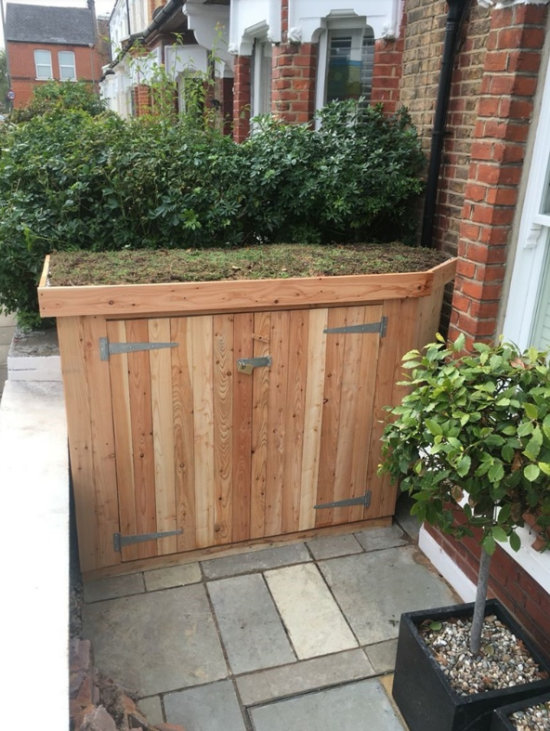Policy CR14
Sustainable waste management
- The council will pursue sustainable waste management, including planning to manage 223,000 tonnes of household and commercial and industrial waste per annum of waste in LBHF by 2041 and seeking, where possible, the movement of waste and recyclable materials by sustainable means of transport, maximising the use of the River Thames where possible.
- All new developments must include suitable facilities for the management of waste generated by the development, including the collection and storage of separated waste and where feasible on-site energy recovery.
a) All developments, including where practicable, conversions and change of use, should aim to minimise waste and should provide convenient facilities with adequate capacity to enable the occupiers to separate, store and recycle their waste both within their own residence and via accessible and inclusive communal storage facilities, and where possible compost green waste on site;
b) In major development proposals, on-site waste management should be provided, particularly for commercial and industrial waste streams; and
c) Sustainable waste behaviour, including the re-use and recycling of construction, demolition and excavation waste will be encouraged and recyclable materials should, wherever feasible, be segregated on site, providing there is no significant adverse impact on either site occupants or neighbours. On larger demolition sites, the council will expect details of the type and quantity of waste arising and details of proposed methods of disposal, including means of transport.
Waste apportionment
5.118 London Plan (2021) policies are seeking to manage as much of London's waste within London as practicable, and are working towards managing the equivalent of 100% of London's waste (municipal and commercial and industrial waste) arising in London. The London Plan sets out the waste apportionment to be managed by London boroughs for household and commercial and industrial waste. Hammersmith and Fulham's apportioned.
5.119 The Western Riverside Waste Authority (WRWA) is the statutory Waste Disposal Authority for LBHF, as well as the London Boroughs of Kensington and Chelsea, Lambeth and Wandsworth. The council is therefore statutorily required to deliver its Local Authority Collected Waste (LACW) to places as directed by the WRWA. Currently all of the LACW goes to the WRWA facilities in the London Borough of Wandsworth for transfer and treatment (Western Riverside Transfer Station near Wandsworth Bridge and Cringle Dock Transfer Station next to Battersea Power Station). Since 2011, recyclables go to the Material Recycling Facility at Smuggler's Way, close to Wandsworth Bridge in the London Borough of Wandsworth. Currently most of the non-recyclable municipal waste is transported by river to an Energy from Waste facility at Belvedere in the London Borough of Bexley.
5.120 In order to manage increasing tonnages of recyclables and compostable waste, there is a need to ensure that major new developments, such as those within the White City Opportunity Area, Earls Court and West Kensington Opportunity Area and Fulham Regeneration Area.
5.121 Two large waste sites (Powerday at Old Oak Sidings and EMR), and some other smaller sites exist within the Old Oak Common Opportunity Area. Since April 2015 this Opportunity Area and the waste sites have fallen within the boundary of the Old Oak and Park Royal Development Corporation (OPDC). OPDC became the local planning authority for part of the Hammersmith and Fulham area, which means that the existing waste sites now fall within OPDC's boundary. Some of these waste sites are being considered for redevelopment as part of plans to develop new homes and jobs in the OPDC area, but OPDC is working with Hammersmith & Fulham Council to help meet the apportionment targets for household and commercial and industrial wastes set out in the London Plan.
5.122 Part of LBHF falls within the boundary of OPDC and therefore a certain proportion of LBHF's waste arisings and capacity will be derived from the OPDC area. As OPDC does not have a waste apportionment target in the current London Plan (2016) OPDC is required to co-operate with LBHF to ensure its apportionment requirements are met
5.123 The council considers that the Old Oak Sidings (Powerday) site can continue to meet LBHF's waste apportionment target set out in the London Plan. The council will be commissioning a Waste Apportionment Study to inform the waste apportionment position.

Waste collection
5.124 As a Waste Collection Authority (WCA), Hammersmith and Fulham Council collects municipal waste which includes household refuse and recyclables, street sweepings, litter, flytipped materials and commercial/industrial waste. Waste collected by the council is delivered to the Western Riverside Waste Authority (WRWA) for disposal or recycling. Mixed recycling comprising glass, metal, paper, cardboard, plastic and cartons is sorted at a Materials Recycling Facility in Wandsworth. Refuse not separated for recycling is disposed of at an Energy from Waste facility in Bexley.
5.125 In the regeneration areas and other major redevelopment schemes, consideration should be given to the provision of on-site waste management in order to facilitate the re-use and recycling of waste generated by the development, particularly for the industrial and commercial waste streams. On-site waste management could have the added benefit of reducing transport trips.
5.126 Construction, excavation and demolition waste should, wherever feasible, be segregated on site in order to maximise reuse and recycling of the waste. On some smaller construction sites in close proximity to residential or noise dust sensitive uses this may not be possible. On larger sites the council will expect developers to produce a Site Waste Management Plan to ensure the efficient handling of waste and materials. Further details on the requirements for on-site waste management is provided within the council's Planning Guidance SPD.
5.127 In order to facilitate the sustainable management of waste in the future it is essential that all developments provide adequate facilities for the separation of waste and recyclables in the home and for its satisfactory storage prior to collection. Where feasible space or facilities for the composting of green waste should also be provided.